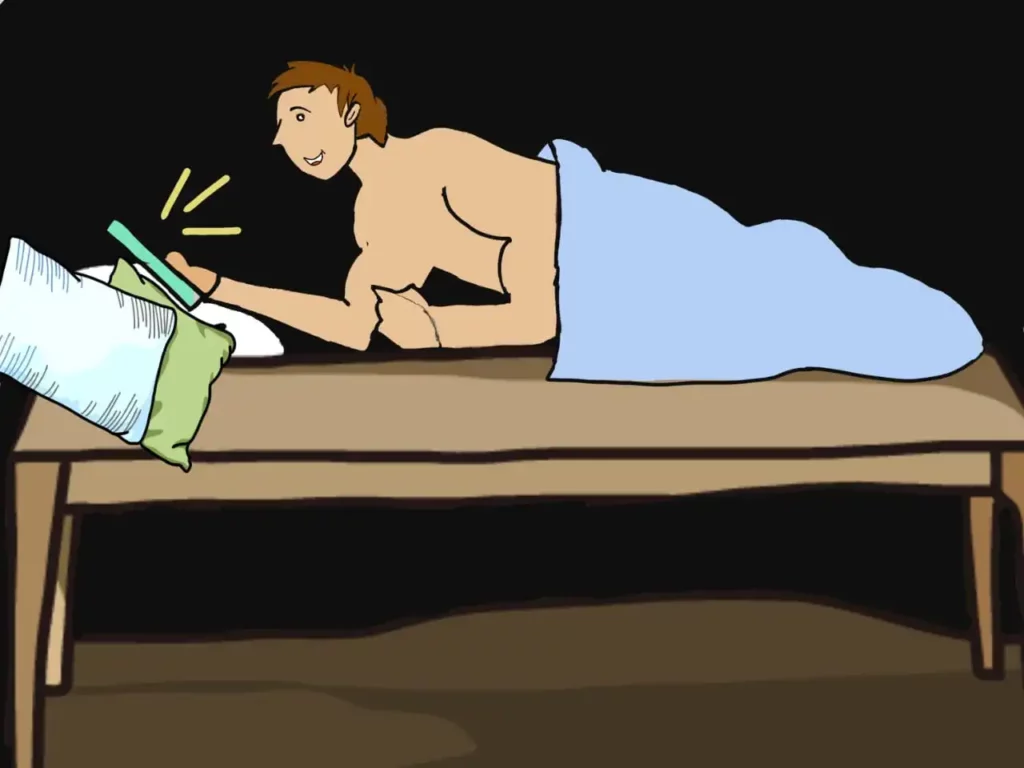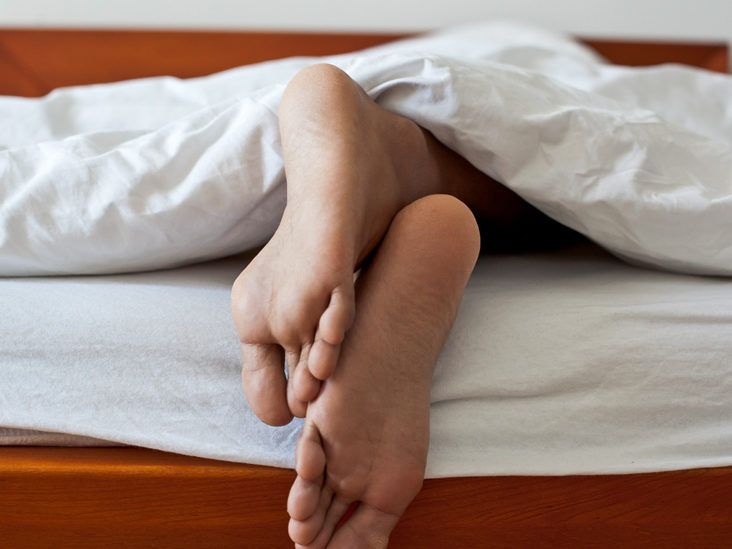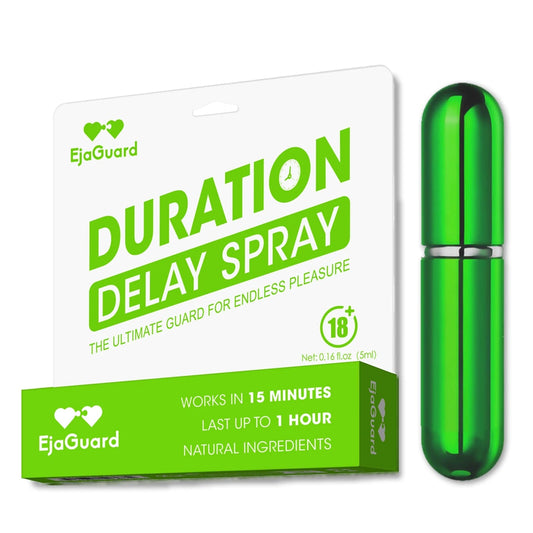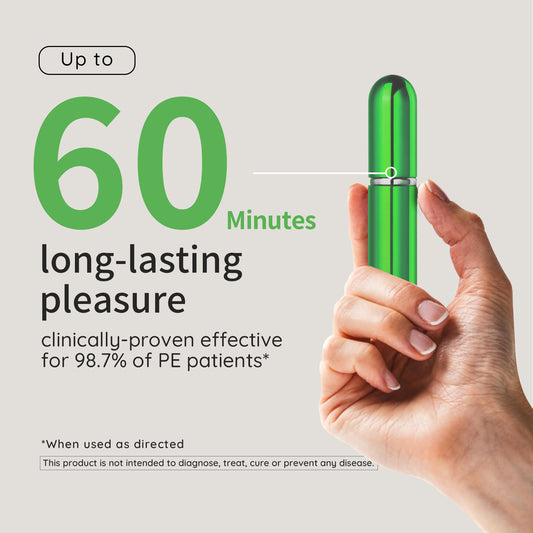الاستمناء أثناء الاستلقاء: ما هو، آثاره، وبدائله الأكثر أمانًا
مقدمة عن الاستمناء في وضعية الانبطاح

هل سمعتَ يومًا بالاستمناء أثناء الاستلقاء؟ إنها طريقةٌ أقل شهرةً، يستلقي فيها الشخص ووجهه لأسفل ويفرك أعضائه التناسلية على سطحٍ ما للوصول إلى النشوة. مع أنها قد تبدو غير ضارة، إلا أن الاستمناء أثناء الاستلقاء له مخاطرٌ فريدةٌ يجهلها معظم الناس.
في هذا الدليل، سنكشف لك كل ما تحتاج إلى معرفته - من الآثار الجانبية إلى البدائل الصحية
ما هو الاستمناء المعرض؟

الاستمناء في وضعية الانبطاح هو تحفيز الذات بالاستلقاء على الوجه وفرك الأعضاء التناسلية على سرير أو وسادة أو سطح مشابه. ولا يتضمن ذلك عادةً استخدام اليدين.
بخلاف الطرق التقليدية التي تعتمد على تحفيز اليد، تُشعر هذه التقنية بتأثير قوي وشخصي للغاية. يبدأ بعض الرجال هذه العادة في سن المراهقة، وقد لا يدركون حتى أنها تختلف عما يفعله معظم أقرانهم.
رغم أن هذه الطريقة قد تبدو فعالة، إلا أنها قد تسبب مشاكل طويلة الأمد فيما يتعلق بالحساسية والتقنية.
بالنسبة لأولئك الذين يستكشفون طرقًا جديدة لتعزيز المتعة الفردية، فإن استخدام جهاز استمناء واقعي يمكن أن يوفر تحفيزًا أكثر أمانًا وتنوعًا من التقنيات المعرضة.
لماذا يمارس بعض الرجال العادة السرية بهذه الطريقة

الرجال الذين يمارسون الاستمناء في وضعية الانبطاح يفعلون ذلك غالبًا لعدة أسباب رئيسية:
-
الراحة : يمكن أن تشعر بالاسترخاء والطبيعية، وخاصة عندما يتم ذلك في السرير.
-
الخصوصية : فهي تصدر ضوضاء أقل وتترك علامات مرئية أقل.
-
تكوين العادة المبكرة : كثير من الناس يتبنونها دون توجيه ويستمرون فيها.
لسوء الحظ، فإن ما يبدأ كعادة مريحة يمكن أن يصبح مصدرًا للصعوبات الجسدية والنفسية في وقت لاحق.
الآثار الجانبية المحتملة للاستمناء أثناء الاستلقاء

على الرغم من أنه قد يبدو مرضيًا في الوقت الحالي، إلا أن الاستمناء أثناء الانتصاب قد يكون له عيوب بمرور الوقت:
-
إزالة التحسس : الضغط المستمر على الأسطح الصلبة قد يقلل من حساسية القضيب.
-
صعوبة في ممارسة الجنس الاختراقي : يذكر بعض الرجال أنهم يواجهون صعوبة في الوصول إلى ذروة الجماع مع شريكة حياتهم بسبب نمط التحفيز الفريد.
-
القذف المتأخر : يمكن أن يعيد برمجة جسمك ليتوقع أنواعًا معينة فقط من الاحتكاك.
-
ضعف الانتصاب (ED) : في بعض الحالات، قد يؤدي الاعتماد على هذه الطريقة إلى جعل الإثارة أثناء ممارسة الجنس الطبيعي أكثر صعوبة.
تعتبر هذه المشكلات أكثر شيوعًا مما يدركه الناس وقد تؤثر على ثقتك بنفسك وأدائك.
للتخفيف من خطر إزالة التحسس، يتم دمج مادة التشحيم أثناء الاستمتاع بالذات، يمكن أن يساعد ذلك في الحفاظ على الحساسية مع تقليل الاحتكاك.
هل الاستمناء أثناء الاستلقاء يسبب ضعف الانتصاب؟
هناك أدلة متزايدة وتخمينات سريرية تشير إلى وجود صلة بين الاستمناء أثناء الانتصاب والضعف الجنسي.
يحدث هذا عندما يعتاد القضيب على أنماط احتكاك شديدة وغير طبيعية. ونتيجةً لذلك، قد لا يوفر الجماع الطبيعي - الذي يتضمن زوايا وأحاسيس مختلفة - تحفيزًا كافيًا.
لذلك، في حين أن الاستمناء أثناء الانتصاب لا يسبب ضعف الانتصاب بشكل مباشر، فإنه يمكن أن يساهم في ظهور أعراض ضعف الإثارة والقلق النفسي بشأن الأداء.
هل يمكن أن يؤثر على الأداء الجنسي أو القدرة على التحمل؟
نعم، قد يؤثر الاستمناء أثناء الانتصاب على القدرة الجنسية والأداء. عندما يُهيئ الرجل جسده للوصول إلى الذروة من خلال ضغط محدد للغاية، فقد:
-
النضال من أجل الحفاظ على الإثارة في المواقف الأكثر شيوعًا
-
تجربة تأخير أو توقف القذف
-
صعوبة الاستمرار لفترة طويلة أثناء ممارسة الجنس مع شريك
نادرًا ما تُدرّب هذه التقنية القدرة على التحمّل. بخلاف الاستمناء على الحافة أو غيره من التقنيات التي تُعزّز القدرة على التحمّل، قد يُقلّل الاستمناء أثناء الاستلقاء من قدرتك على الاستمرار لفترة أطول في السرير.
يمكن أن يكون التدريب باستخدام أدوات بناء القدرة على التحمل مثل بخاخات التأخير بديلاً عمليًا لأولئك الذين يتطلعون إلى تعزيز القدرة على التحمل والتحكم.

تقنيات وبدائل الاستمناء الصحية
إذا كنت تعتقد أن الاستمناء أثناء الانتصاب يؤثر على أدائك، فإليك بعض البدائل الأكثر أمانًا:
-
التحفيز اليدوي : يحاكي أحاسيس العلاقة الحميمة بين الشريكين بشكل أكثر دقة.
-
استخدام مواد التشحيم : يقلل الاحتكاك ويحاكي الرطوبة الطبيعية.
-
اليقظة المثيرة : تدرب على التواجد والتركيز على تنفسك لتستمر لفترة أطول.
-
التأخير : تأخير الوصول إلى النشوة الجنسية عمدًا لزيادة التحكم والمتعة.
تعمل هذه الأساليب على تعزيز التحكم بشكل أكبر، وأحاسيس أكثر صحة، وقابلية أفضل للانتقال إلى العلاقة الحميمة بين الشريكين.
إن استخدام جل النشوة الجنسية عالي الجودة يمكن أن يعزز الأحاسيس ويوفر بديلاً جديدًا وآمنًا للجسم للطرق القائمة على الضغط.
نصائح للتوقف عن الاستمناء أثناء الاستلقاء (إذا لزم الأمر)
تغيير العادات ليس سهلاً، ولكنه ممكن. إليك خطوات عملية:
-
حدد المحفزات الخاصة بك : اعرف متى ولماذا تفعل ذلك.
-
تغيير بيئتك : قم بإزالة الوصول إلى الأسطح التي تشجع السلوك.
-
استخدم يديك بدلاً من ذلك : قم بإعادة تدريب جسمك على تحفيزات مختلفة.
-
تأخير الاستمناء : جرب NoFap أو توزيع الجلسات لكسر الدورة.
-
تحدث عن الأمر : فكر في التحدث إلى معالج أو الانضمام إلى المنتديات عبر الإنترنت للحصول على الدعم.
يمكن أن تساعدك التغييرات السلوكية، مثل تمارين كيجل، على استعادة ثقتك الجنسية.
لدعم تغيير السلوك، يرى البعض أن استخدام الدمى الجنسية الواقعية أو أدوات الاستمناء يساعد على إعادة تدريب أجسامهم نحو أشكال تحفيز أكثر صحة.
التمارين ذات الصلة (تمارين كيجل، وتمارين الحواف، وما إلى ذلك)
لتحسين التحكم والحساسية، قم بدمج ما يلي في روتينك:
-
تمارين كيجل : تقوية عضلات قاع الحوض وتعزيز القدرة على التحمل
-
الحافة : بناء سيطرة أفضل على النشوة الجنسية
-
الضربات البطيئة : علّم جسدك الاستمتاع بالتحفيز الممتد
-
بخاخات مزيلة للحساسية : إذا لزم الأمر، لتقليل فرط الحساسية أثناء ممارسة الجنس بين الشريكين
إن الجمع بين هذه الممارسات مع عادات أفضل يمكن أن يحسن الأداء والمتعة بشكل كبير.
إن استخدام كريمات تكبير القضيب وإصلاحه قد يؤدي أيضًا إلى تحسين تدفق الدم والحساسية، مما يعزز روتينك.
الخاتمة والأفكار النهائية
قد يبدو الاستمناء أثناء الانتصاب غير ضار، ولكنه قد يؤثر سلبًا على الصحة الجنسية مع مرور الوقت. بفهم تأثيره وتبني بدائل أكثر أمانًا، يمكنك التحكم في متعتك وتحسين صحتك الجنسية بشكل عام.
هل أنت مستعد لزيادة قدرتك على التحمل ورضاك؟ جرب تغيير أسلوبك اليوم واكتشف حلول EjaGuard الطبيعية التي تساعدك على الاستمرار لفترة أطول.
 Buy Now
Buy Now



